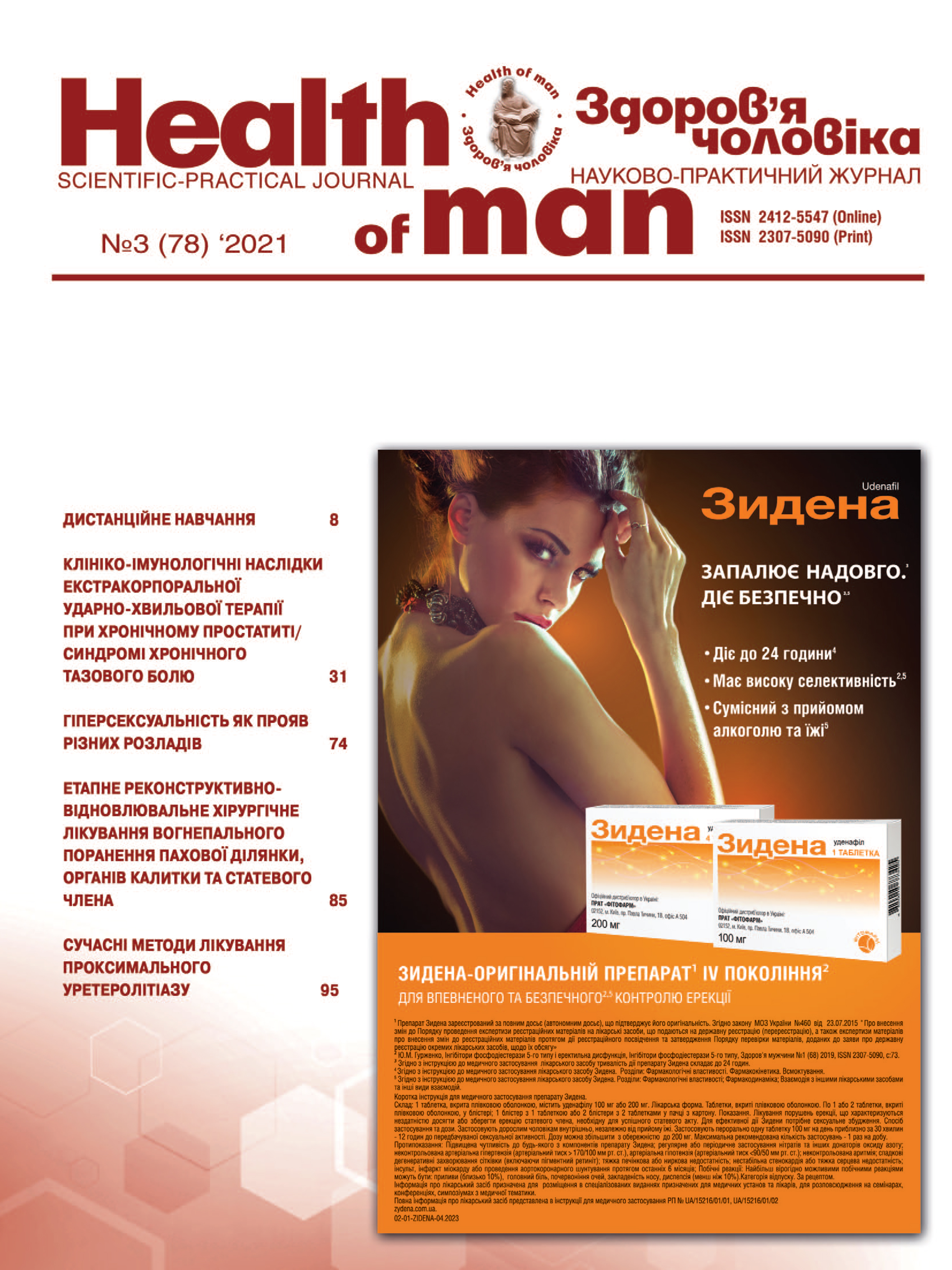Clinical and Immunological Outcomes of Extracorporeal Shock Wave Therapy in Chronic Prostatitis/Chronic Pelvic Pain Syndrome
##plugins.themes.bootstrap3.article.main##
Abstract
Extracorporeal shock wave therapy (ESWT) is a non-pharmacological, non-invasive procedure for the treatment of chronic prostatitis/chronic pelvic pain syndrome (CP/CPPS).
The objective: to evaluate the dynamics and relationship of clinical symptoms and ejaculate cytokine concentrations during the use of ESWT in the treatment of patients with CP/CPPS.
Materials and methods. The study included 37 patients aged 18–45 years with CP/CPPS who received ESWT in the projection of the prostate and seminal vesicles. Symptoms of prostatitis were assessed by the NIH-CPSI scale, and ejaculate cytokines were assessed by ELISA before and after treatment. To analyze the results of treatment, patients with a significant reduction in the activity of prostatitis symptoms (by 6 or more points on the NIH-CPSI scale) were grouped into subgroup A. Patients with insufficient efficacy were grouped into subgroup B.
Results. After treatment, 21 (57%) patients significantly reduced the intensity of prostatitis symptoms (subgroup A). Patients with insufficient efficacy were grouped into subgroup B. The content of proinflammatory cytokine – interleukin-1β ejaculate significantly (p<0.05) increased only in these patients. In subgroup A, a significant correlation was found between the assessment of prostatitis symptoms on the NIH-CPSI scale and the concentration of interleukin-1β ejaculate (Spearman’s r=0.650; p<0.001 and r=0.735; p<0.001 before and after treatment, respectively). The concentration of the anti-inflammatory cytokine ejaculate (interleukin-10) increased significantly only in subgroup A (p<0.05).
Conclusion. Extracorporeal shock wave therapy provides a significant reduction in the symptoms of prostatitis causing dosed minimal damage and inflammation of the prostate and seminal vesicles, associated with an increase in the level of interleukin-1β in the ejaculate.
##plugins.themes.bootstrap3.article.details##

This work is licensed under a Creative Commons Attribution 4.0 International License.
Authors retain the copyright and grant the journal the first publication of original scientific articles under the Creative Commons Attribution 4.0 International License, which allows others to distribute work with acknowledgment of authorship and first publication in this journal.
References
Krieger JN, Nyberg L Jr, Nickel JC. NIH consensus definition and classification of prostatitis. JAMA. 1999 Jul 21;282(3):236-7. DOI: 10.1001/jama.282.3.236. PMID: 10422990.
EAU Guidelines. Edn. presented at the EAU Annual Congress Milan 2021. ISBN 978-94-92671-13-4.
Hausner T, Nógrádi A. The use of shock waves in peripheral nerve regeneration: new perspectives? Int Rev Neurobiol. 2013;109:85-98. DOI: 10.1016/B978-0-12-420045-6.00003-1
Schmitz C, Császár NB, Milz S, Schieker M, Maffulli N, Rompe JD, Furia JP. Efficacy and safety of extracorporeal shock wave therapy for orthopedic conditions: a systematic review on studies listed in the PEDro database. Br Med Bull. 2015;116(1):115-38. DOI: 10.1093/bmb/ldv047. Epub 2015 Nov 18.
Zimmermann R, Cumpanas A, Miclea F, Janetschek G. Extracorporeal shock wave therapy for the treatment of chronic pelvic pain syndrome in males: a randomised, double-blind, placebo-controlled study. Eur Urol. 2009 Sep;56(3):418-24. DOI: 10.1016/j.eururo.2009.03.043. Epub 2009 Mar 25. Erratum in: Eur Urol. 2020 May;77(5):e140.
Pajovic B, Radojevic N, Dimitrovski A, Vukovic M. Comparison of the efficiency of combined extracorporeal shock-wave therapy and triple therapy versus triple therapy itself in Category III B chronic pelvic pain syndrome (CPPS). Aging Male. 2016 Sep;19(3):202-207. DOI: 10.1080/13685538.2016.1197899. Epub 2016 Jul 5.
Yuan P, Ma D, Zhang Y, Gao X, Liu Z, Li R, Wang T, Wang S, Liu J, Liu X. Efficacy of low-intensity extracorporeal shock wave therapy for the treatment of chronic prostatitis/chronic pelvic pain syndrome: A systematic review and meta-analysis. Neurourol Urodyn. 2019 Aug;38(6):1457-1466. DOI: 10.1002/nau.24017. Epub 2019 Apr 29.





